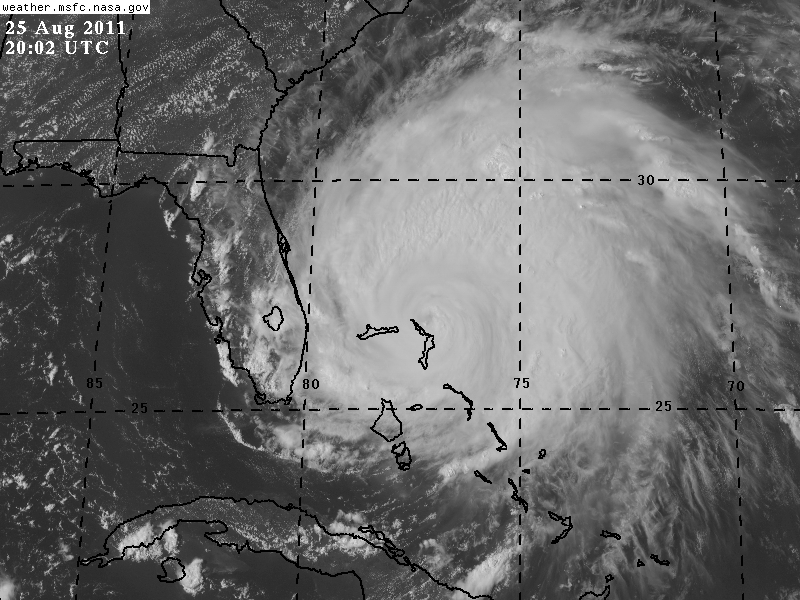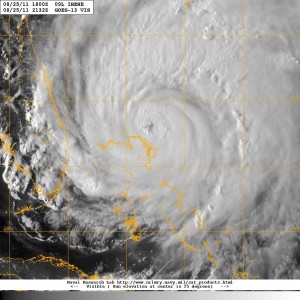25 August 2011
What To Expect From Irene If You Are In Her Path
Posted by Dan Satterfield
 Hurricane Irene remains a dangerous hurricane, and overnight numerical weather prediction models have shifted a bit back tot he west. This increases the risk of a land falling hurricane in New Jersey or on Long Island, followed by a track across the highly populated areas of New England. It’s possible that Irene may pass near or west of New York City and Boston. While Irene will start to pass over some cooler water, and see increasing wind shear, it is still very possible that it will be near category two strength as it reaches the New Jersey/New York area late Sunday morning.
Hurricane Irene remains a dangerous hurricane, and overnight numerical weather prediction models have shifted a bit back tot he west. This increases the risk of a land falling hurricane in New Jersey or on Long Island, followed by a track across the highly populated areas of New England. It’s possible that Irene may pass near or west of New York City and Boston. While Irene will start to pass over some cooler water, and see increasing wind shear, it is still very possible that it will be near category two strength as it reaches the New Jersey/New York area late Sunday morning.

Image from CIMMS (u. Wisc.) The blue swath is a satellite based "radar" pass. Most of NWP models are showing a track near or west of NYC.
Many people in the Northeast have not experienced the eye-wall of a strong hurricane and may react based on the near misses in the past or from little or no experience at all. So, below are a few things you might not know. These are based on forecast knowledge, and from being in the eye of three hurricanes (and near the eye wall of 3 others).
1. The satellite presentation can be deceptive. The winds are only steady at near hurricane force right near the eye (within 25-50 miles depending on the storm).
2. As the storm approaches you will see a lowering cirrus overcast and then begin to experience rain bands. The winds will pick up considerably as the rain bands pass but then will die down. The rain bands will become more frequent and then steady wind and rain will develop.
3. When the wind gets above 60 kts. or so you will hear a low moaning sound that can be quite unnerving.
4. Those blue flashes you see are not lightning, but power transformers arcing.
5. The winds near the coast will be MUCH stronger than the winds 10 miles inland but they will rise rapidly as the eye approaches.
6. Winds will diminish some but no go calm in the eye. If the eye passes directly over you, they will get quite light and become variable in direction for a brief time.
7. Beware of the storm surge! Just before the eye makes landfall, the water will rise suddenly and substantially. If the eye is 90 minutes away and you think the flooding will not be bad, you may be making the same deadly mistake that killed at least 6,000 in Galveston.
8. If the eye passes just to your west, you will receive much stronger winds than someone on left side of the eye. If the storm center is passing to your west or south then you are on the windy side.
9. Some good news: this storm will move quickly through New England ( high confidence in that) so flooding from heavy rainfall will not be as big a problem as in some hurricanes along the Gulf Coast.
10. Flooding will depend on the slope of the sea-bed and the wind direction. Very sophisticated models have been developed to predict the flooding and if your area is singled out, take precautions or better yet, get out.
After Katrina, I think that evacuations have been a little on the high side compared to common sense, look at the flooding projections and know your location and circumstances when making the decision to leave or not. If you’re in a low spot near the coast, you should probably leave if your area is in an evacuation zone. Many people now hesitate to evacuate because, if there is major damage, they will not be allowed in for days and weeks after the storm. This IMHO has caused fewer people to get out, and I cannot say that I blame them.
Make a smart decision, that is based on the best forecasts and your location. Keep in mind that the force of the wind increases with the square of the velocity. If the wind doubles from 50 to 100 knots, the force goes up by ~4 times.



 Dan Satterfield has worked as an on air meteorologist for 32 years in Oklahoma, Florida and Alabama. Forecasting weather is Dan's job, but all of Earth Science is his passion. This journal is where Dan writes about things he has too little time for on air. Dan blogs about peer-reviewed Earth science for Junior High level audiences and up.
Dan Satterfield has worked as an on air meteorologist for 32 years in Oklahoma, Florida and Alabama. Forecasting weather is Dan's job, but all of Earth Science is his passion. This journal is where Dan writes about things he has too little time for on air. Dan blogs about peer-reviewed Earth science for Junior High level audiences and up.